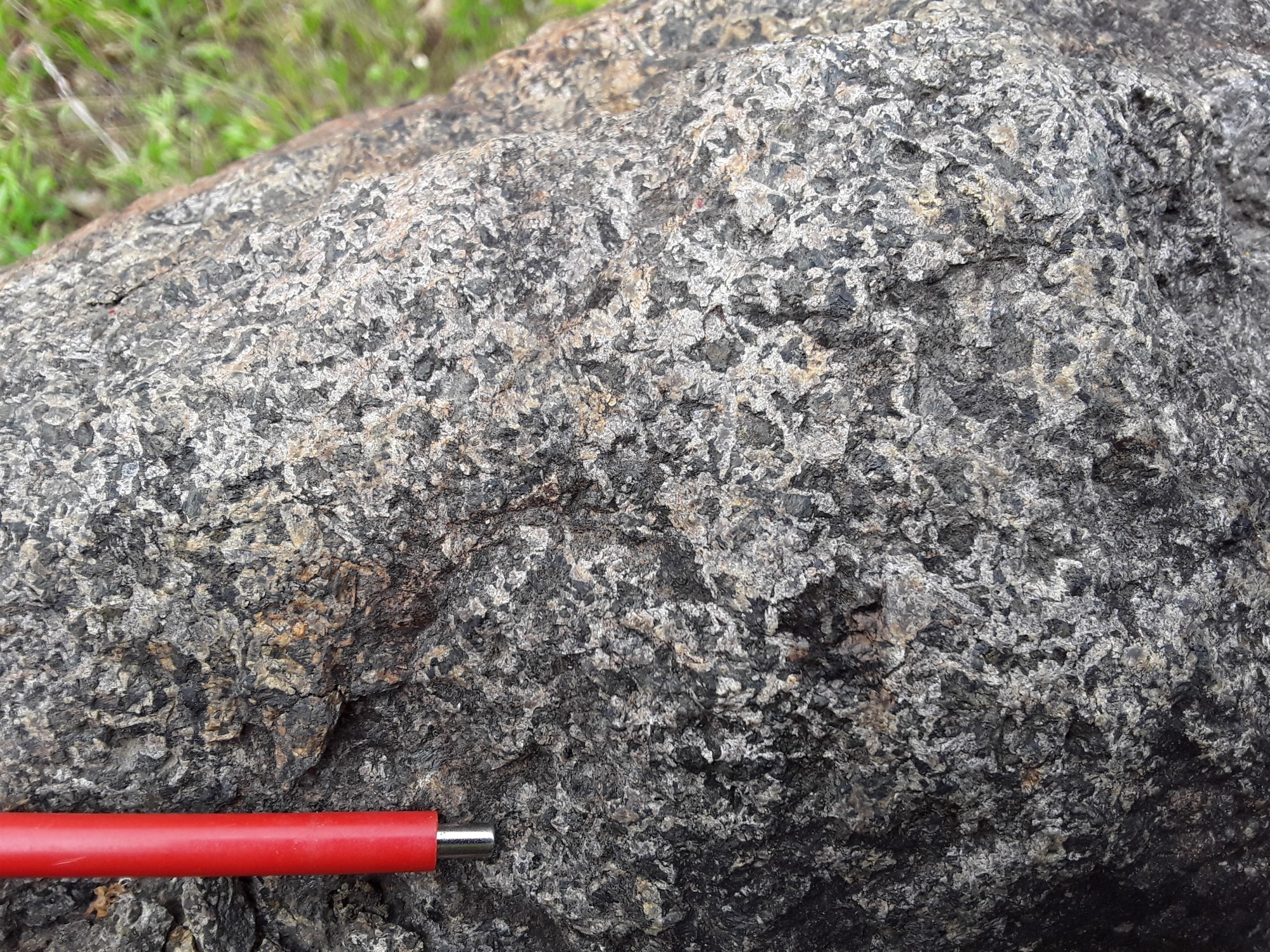
DISCLAIMER: This English version is translated from the original French. In case of any discrepancy, the French version shall prevail.
| Author(s): | Bilodeau, 2022 |
| Age: | Mesoproterozoic |
| Stratotype: | Reference outcrops 2021-CB-1008, 2021-CB-1135 and 2021-CB-1087 |
| Type area: | Île-du-Grand-Calumet (NTS sheet 31F10) |
| Geological province: | Grenville Province |
| Geological subdivision: | Allochton |
| Lithology: | Mafic intrusive rocks |
| Category: | Lithodemic |
| Rank: | Suite |
| Status: | Formal |
| Use: | Active |
None
Background
The Chenaux Intrusive Suite was introduced by Bilodeau (2022) following a geological survey carried out in the Île-du-Grand-Calumet area (sheet 31F10) in 2021. The unit includes the « Chenaux Gabbro », a pluton named by the Ontario Geological Survey (Lumbers, 1982). This name was used in subsequent geological surveys (Abdurahman, 1989; Azar and Easton, 2015). Part of the unit was described in the area of the Bryson Municipality, in Québec, following various geological mapping campaigns carried out by the Ministère (Osborne, 1944; Katz, 1976; Madore et al., 1994).
Description
The Chenaux Intrusive Suite comprises two gabbro plutons outcropping in the Île-du-Grand-Calumet area, in the Bryson and Portage-du-Fort municipalities. Each has its own lithological, structural and geochemical characteristics. Informal units mPchn1 and mPchn1a may correspond to two distinct intrusions; they have been subdivided to highlight their petrographic and structural differences.
Chenaux Intrusive Suite 1 (mPchn1): Subophitic and mesocratic gabbro, layers of fine-grained melanocratic gabbro
Unit mPchn1 is a gabbro pluton located in the Bryson municipality. It consists mainly of fine- to medium-grained, massive and homogeneous mesogabbro. The edges of the intrusion locally contain a subfacies of fine-grained melanocratic metagabbro. Certain contacts of the intrusion are affected by deformation, giving this subfacies the appearance of banded amphibolite. Unit mPchn1 is locally intruded by dykes and sills of coarse-grained hololeucocratic granite, tonalite and quartz diorite, particularly at the edge of the intrusion.
Main Mesocratic Facies
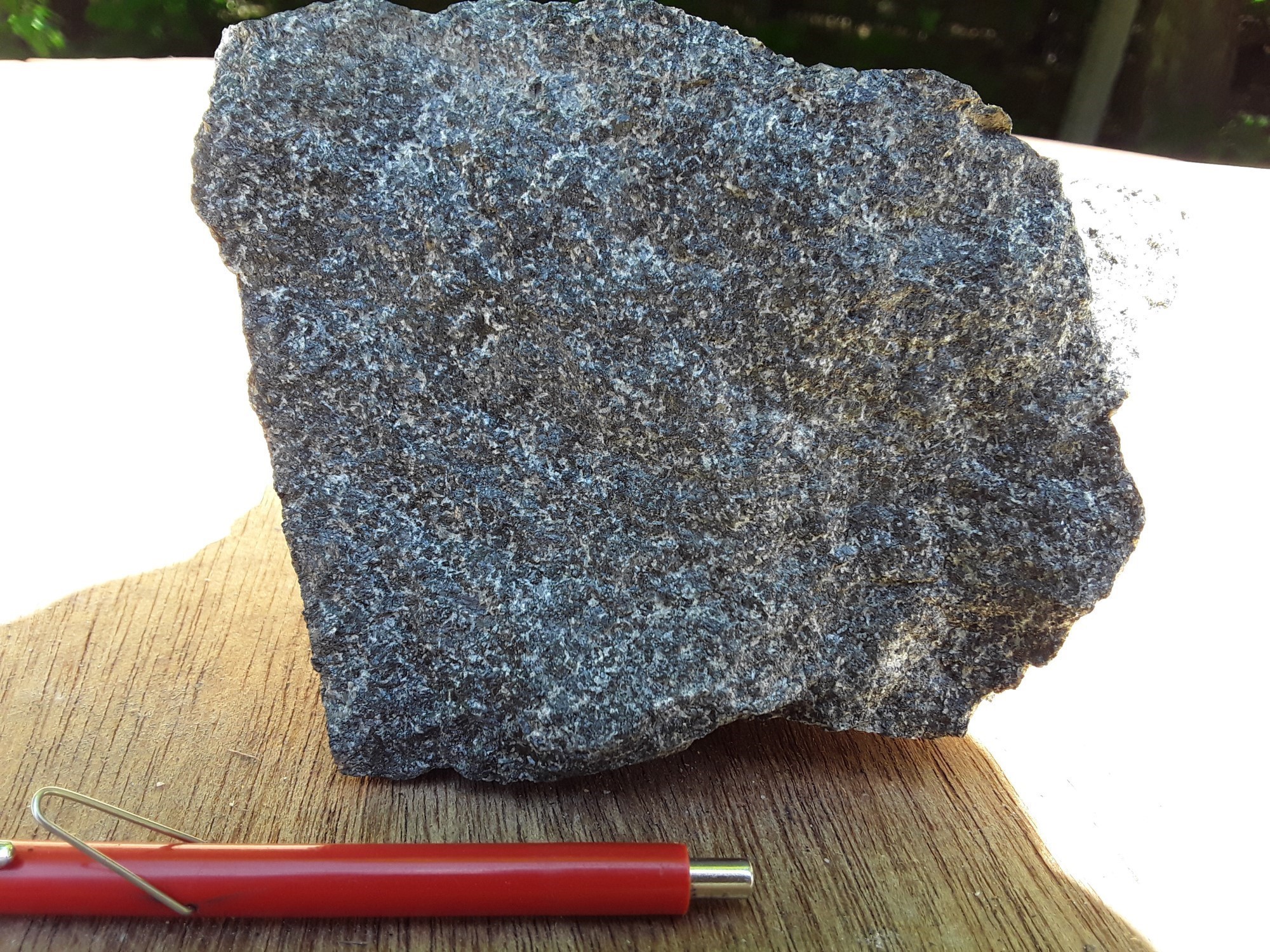
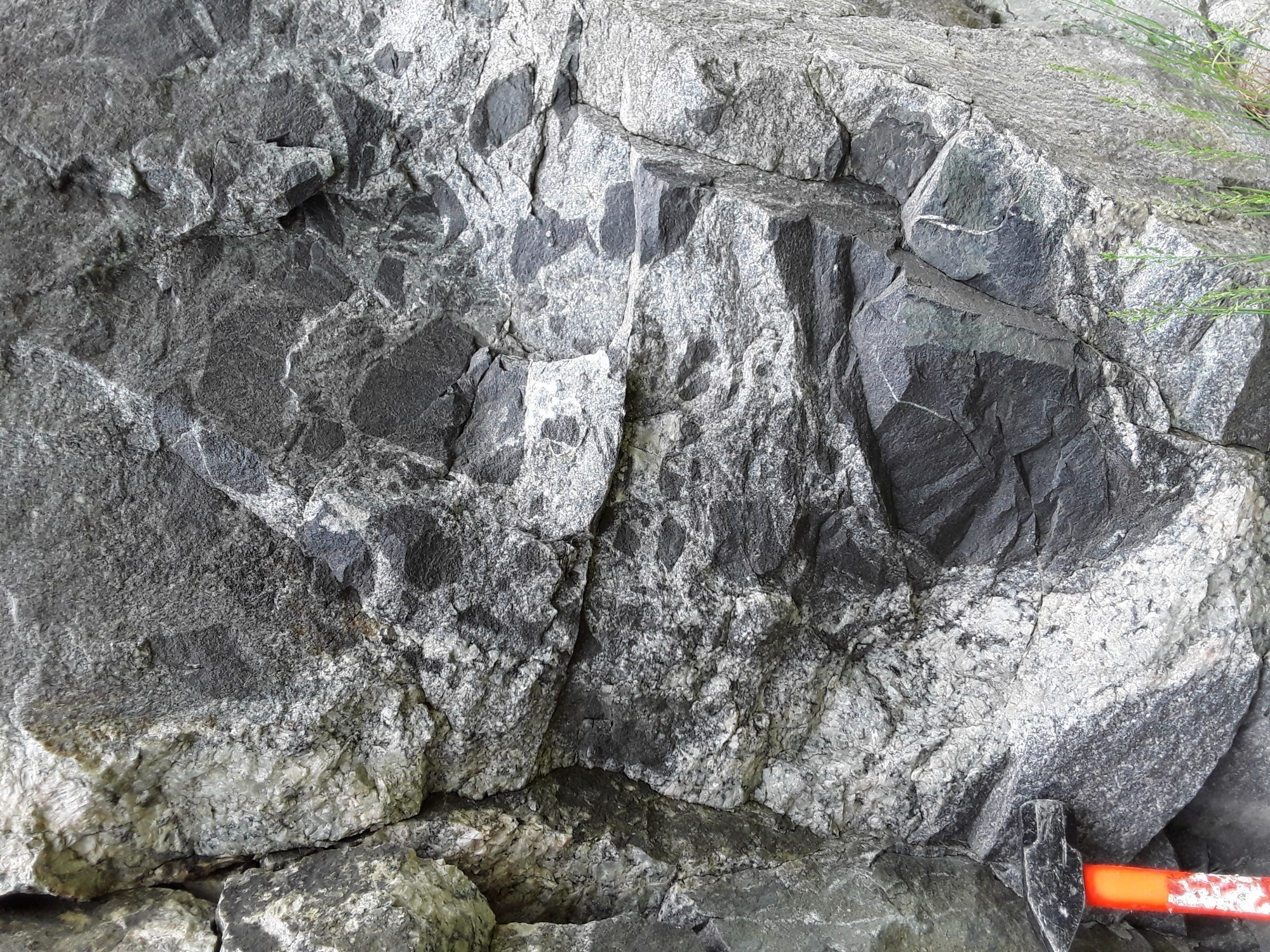 The mesocratic facies typically has a dark to very dark grey alteration patina and a very dark grey to greenish-grey fresh surface. This facies is composed of 40% to 50% unaltered euhedral plagioclase without preferential orientation and ~50% clinopyroxene with preserved cores and uralitized rims. Orthopyroxene crystals were observed in very small proportions in a few samples. Ferromagnesian minerals fill the space between the plagioclase crystals, giving this facies a characteristic subophitic texture. A later generation of euhedral hornblende of medium and locally coarse grain size is observed. Accessory minerals include garnet, orthopyroxene, olivine, titanite, apatite, magnetite, ilmenite, spinel and sulphides (Madore et al., 1994). The latter represent up to 2% of the volume of the rock in the form of small pyrite clusters as well as pyrite and pyrrhotite veinlets or isolated cubic crystals.
The mesocratic facies typically has a dark to very dark grey alteration patina and a very dark grey to greenish-grey fresh surface. This facies is composed of 40% to 50% unaltered euhedral plagioclase without preferential orientation and ~50% clinopyroxene with preserved cores and uralitized rims. Orthopyroxene crystals were observed in very small proportions in a few samples. Ferromagnesian minerals fill the space between the plagioclase crystals, giving this facies a characteristic subophitic texture. A later generation of euhedral hornblende of medium and locally coarse grain size is observed. Accessory minerals include garnet, orthopyroxene, olivine, titanite, apatite, magnetite, ilmenite, spinel and sulphides (Madore et al., 1994). The latter represent up to 2% of the volume of the rock in the form of small pyrite clusters as well as pyrite and pyrrhotite veinlets or isolated cubic crystals.
Melanocratic Subfacies
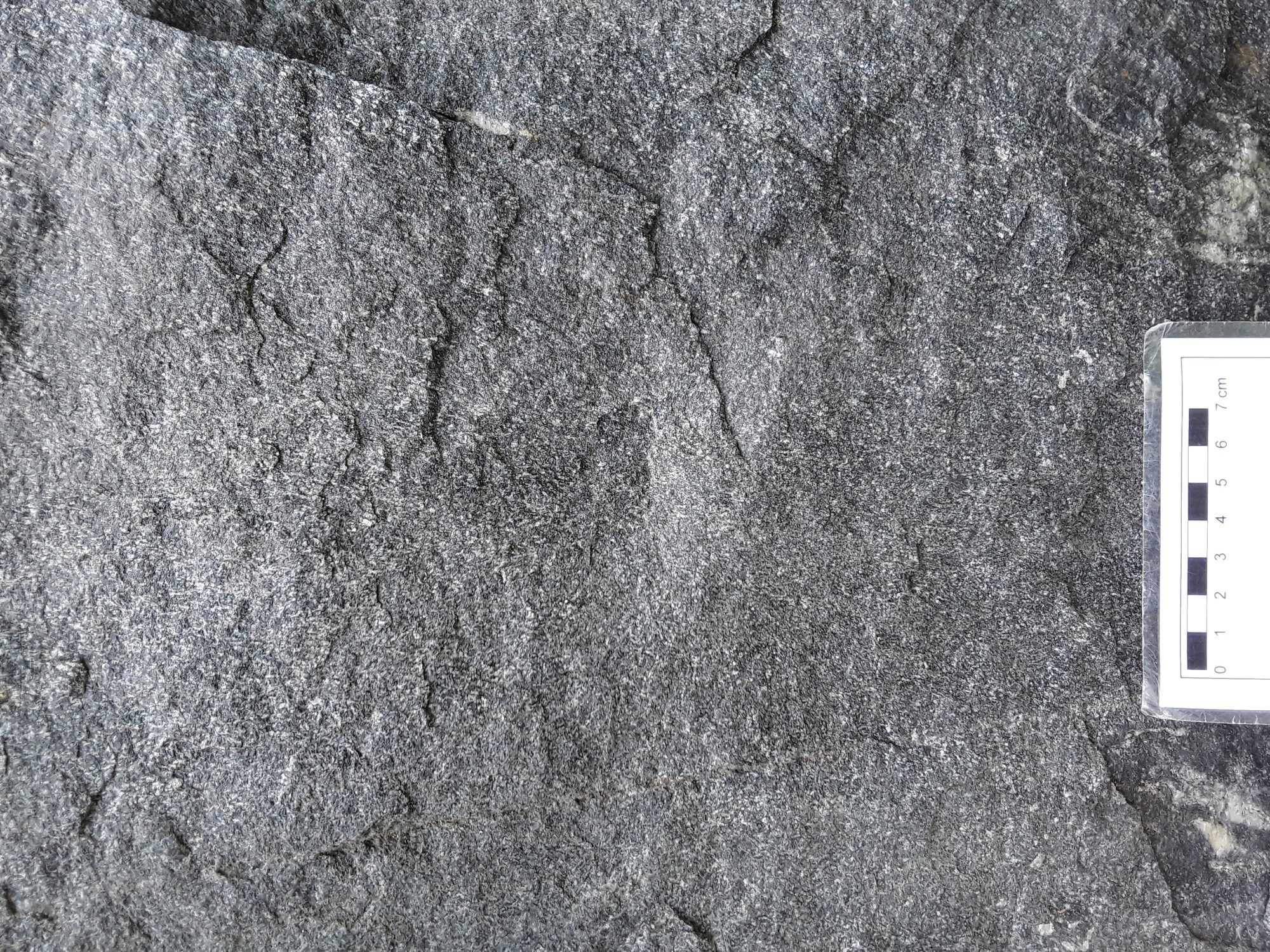
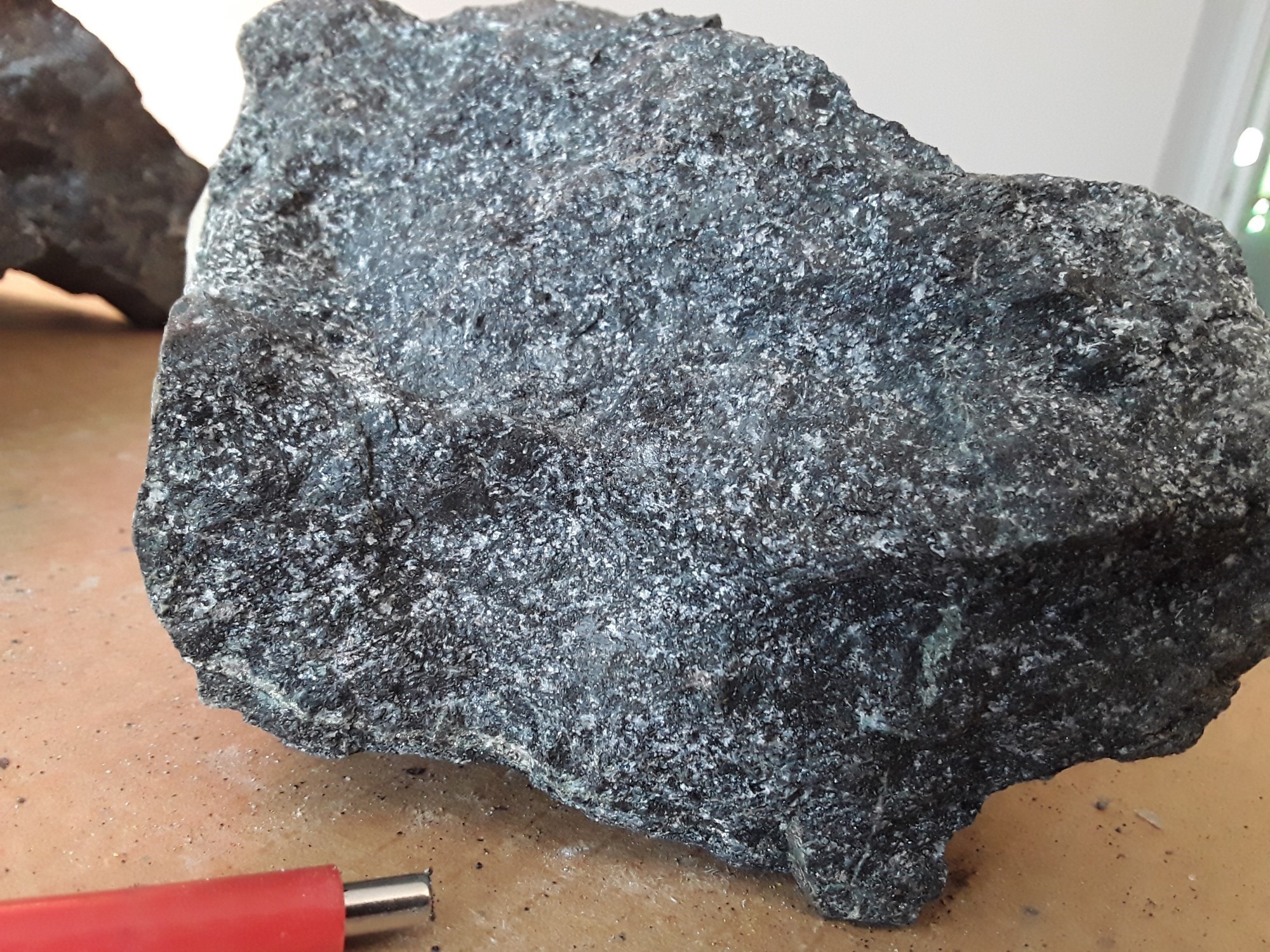 The melanocratic parts of the intrusion’s edge are black on the weathered and fresh surfaces. The plagioclase is locally recrystallized, slightly damouritized and present as small clusters of heterogranular crystals forming triple junction between them. The light-coloured altered minerals are beige. This facies is composed of 40% to 50% fine granoblastic hornblende homogeneously filling the interstices of plagioclase crystals. Up to 5% unaltered clinopyroxene and 3% unaltered orthopyroxene are found in fairly homogeneously distributed crystals associated with hornblende as well as up to 12% epidote in the intrusion border zones. This facies generally has a lower magnetic susceptibility than the mesocratic facies.
The melanocratic parts of the intrusion’s edge are black on the weathered and fresh surfaces. The plagioclase is locally recrystallized, slightly damouritized and present as small clusters of heterogranular crystals forming triple junction between them. The light-coloured altered minerals are beige. This facies is composed of 40% to 50% fine granoblastic hornblende homogeneously filling the interstices of plagioclase crystals. Up to 5% unaltered clinopyroxene and 3% unaltered orthopyroxene are found in fairly homogeneously distributed crystals associated with hornblende as well as up to 12% epidote in the intrusion border zones. This facies generally has a lower magnetic susceptibility than the mesocratic facies.
Chenaux intrusive suite 1a (mPchn1a): Fine-grained heterogeneous gabbro, layers of banded amphibolite derived from gabbro
Unit mPchn1a is a microgabbro intrusion with a geochemical signature similar to that of unit mPchn1, but with its own petrographic and structural characteristics. It consists of heterogeneous, massive to foliated rocks and contains layers of banded amphibolite derived from gabbro. The microgabbro has a variable alteration patina colour, generally grey to dark grey and locally dark brown or black. The fresh surface is very dark grey to black. The rock is composed of 50% homogeneously distributed fine to medium euhedral hornblende and 30% to 50% euhedral plagioclase without preferential orientation. One can find up to 20% of crystal relicts interpreted as pyroxenes completely replaced by clusters of amphibole, notably tremolite and hornblende. These clusters also contain small crystals of euhedral, unaltered plagioclase and fine biotite. Zoned crystals of clinopyroxene with laminae of orthopyroxene exsolutions have been observed in some samples (Katz, 1976). Accessory minerals include epidote, chlorite, apatite, magnetite and ilmenite.
 There are local grain size variations in small, centimetric to decimetric diffuse zones. The rock is generally mesocratic to melanocratic and some outcrops contain diffuse or clear partings of coarser-grained mafic leucocratic material. The subophitic texture that characterizes the pluton of subunit mPchn1 has only been observed locally in subunit 1a. Magnetic susceptibility varies from very weak to very high. Partings of banded amphibolite exhibits slight mineral segregation and grain size variations. The fine-grained gabbro is locally cut by felsic to intermediate intrusions, including a family of small dark pink sills of granular granite depleted in ferromagnesian minerals and enriched in radioactive minerals. Radiometric data of 2000 counts/second was recorded in one of these intrusions (2021-CB-1135).
There are local grain size variations in small, centimetric to decimetric diffuse zones. The rock is generally mesocratic to melanocratic and some outcrops contain diffuse or clear partings of coarser-grained mafic leucocratic material. The subophitic texture that characterizes the pluton of subunit mPchn1 has only been observed locally in subunit 1a. Magnetic susceptibility varies from very weak to very high. Partings of banded amphibolite exhibits slight mineral segregation and grain size variations. The fine-grained gabbro is locally cut by felsic to intermediate intrusions, including a family of small dark pink sills of granular granite depleted in ferromagnesian minerals and enriched in radioactive minerals. Radiometric data of 2000 counts/second was recorded in one of these intrusions (2021-CB-1135).
Chenaux Intrusive Suite 2 (mPchn2): Subophitic and mesocratic gabbro, layers of melanocratic microgabbro
Unit mPchn2 represents a second major gabbro pluton in the Île-du-Grand-Calumet area, almost all of which outcrops in Ontario. Works by Azar and Easton (2015) resulted in the subdivision of the unit into four distinct facies: 1) a main facies of alkaline metagabbro, 2) a group of olivine leucogabbro, leucotroctolite and gabbronorite, 3) a highly magnetic oxides-bearing mesogabbro, locally brecciated or pegmatitic, and 4) a facies of gabbro-derived hornblendite and magnetic amphibolite.
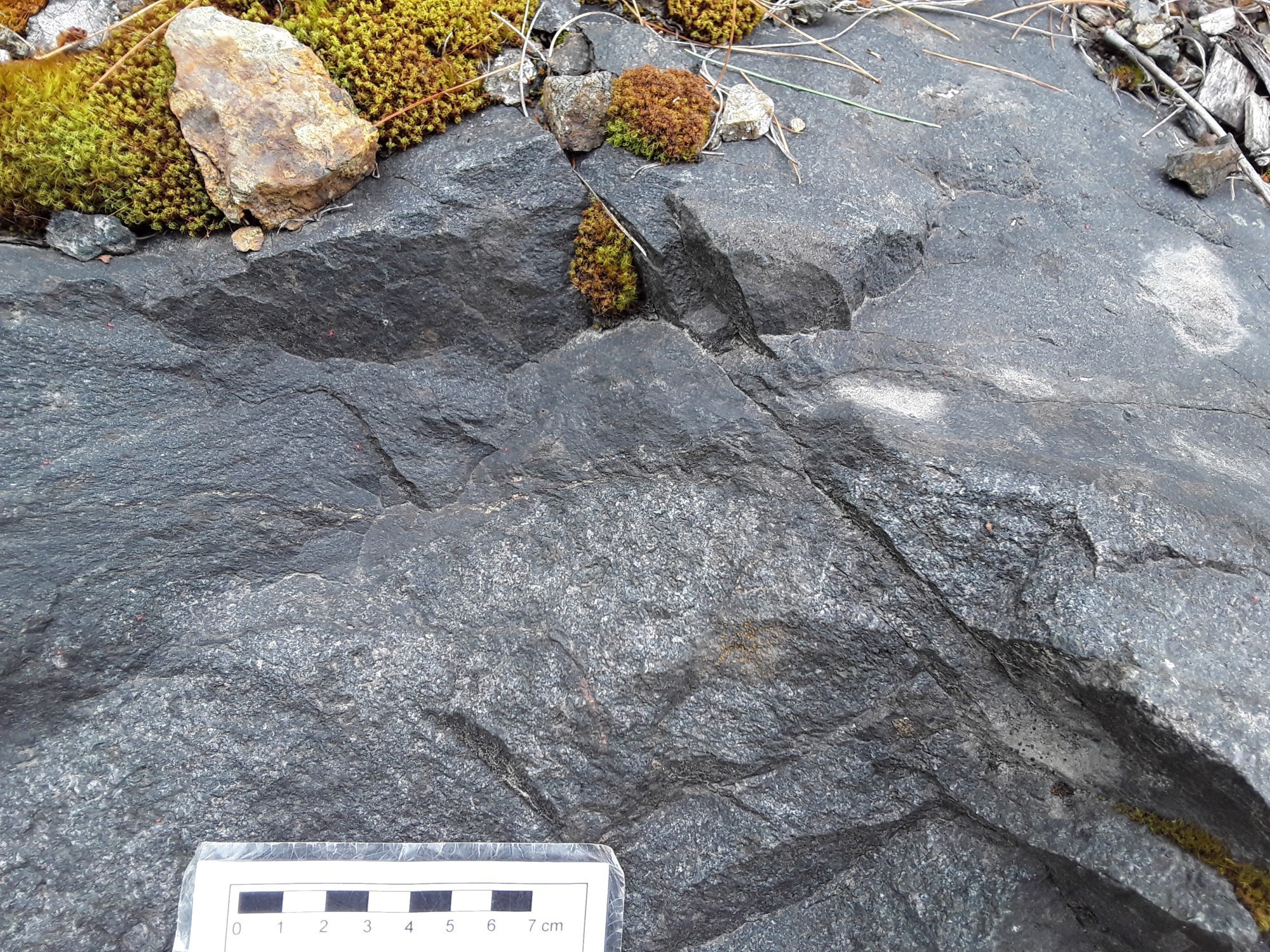

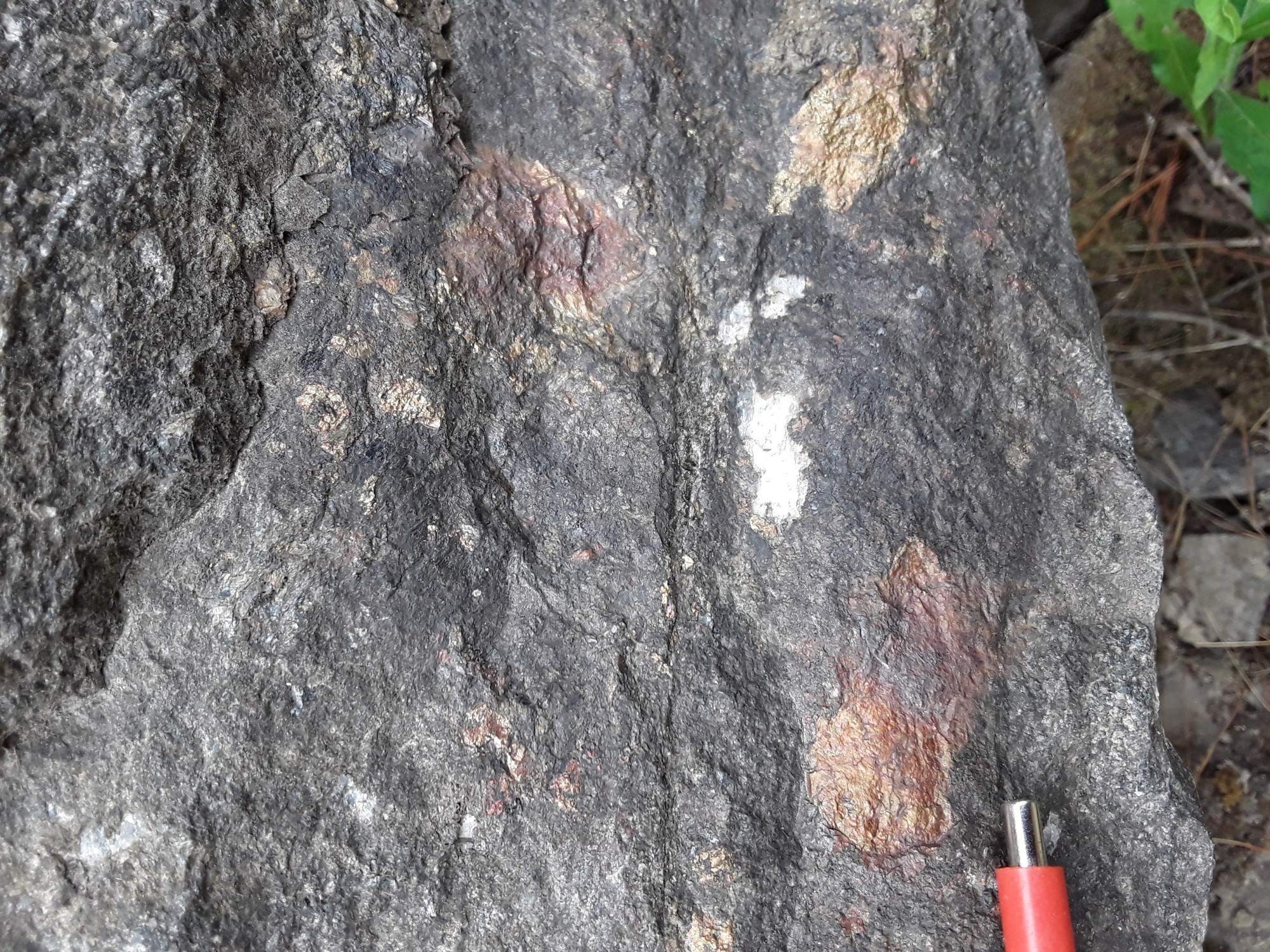 The small part of the intrusion located in Québec consists of a massive, homogeneous, subophitic, mesocratic gabbro, probably corresponding to the oxides-bearing mesogabbro facies defined by Azar and Easton (2015). The magnetic susceptibility of the samples varies from very weak to moderate. The rock is generally fine to medium grained. However, in places it contains partings in sharp or diffuse contacts with a gabbro of similar composition, fine-grained and melanocratic in appearance. Alternating centimetric to decimetric layers of these two facies have been interpreted as magmatic bedding preserved in the part of the intrusion located in Ontario (Azar and Easton, 2015). The alteration patina of the mesocratic facies is very dark grey to very dark brownish-grey and the fresh surface is very dark grey. The finer-grained parts are very dark grey to black on the fresh and weathered surfaces. The rock is composed of 50% euhedral plagioclase in large laths and stocky crystals containing slightly deformed twins The plagioclase is generally unaltered, but displays slight saussuritization associated with microfractures. The gabbro is composed of a maximum of 50% clinopyroxene slightly uralitized into homogeneously distributed medium-grained amphibole. Some samples contain 40% to 50% clinopyroxene relicts completely replaced by fine to medium hornblende. The rock contains 2% to 6% of fine to medium, homogeneously distributed iron oxides and sulphides, generally associated with ferromagnesian minerals. Centimetric clusters of pyrite and marcasite have been observed in outcrops punctually. Accessory minerals include magnetite, ilmenite, olivine, serpentine, titanite and apatite.
The small part of the intrusion located in Québec consists of a massive, homogeneous, subophitic, mesocratic gabbro, probably corresponding to the oxides-bearing mesogabbro facies defined by Azar and Easton (2015). The magnetic susceptibility of the samples varies from very weak to moderate. The rock is generally fine to medium grained. However, in places it contains partings in sharp or diffuse contacts with a gabbro of similar composition, fine-grained and melanocratic in appearance. Alternating centimetric to decimetric layers of these two facies have been interpreted as magmatic bedding preserved in the part of the intrusion located in Ontario (Azar and Easton, 2015). The alteration patina of the mesocratic facies is very dark grey to very dark brownish-grey and the fresh surface is very dark grey. The finer-grained parts are very dark grey to black on the fresh and weathered surfaces. The rock is composed of 50% euhedral plagioclase in large laths and stocky crystals containing slightly deformed twins The plagioclase is generally unaltered, but displays slight saussuritization associated with microfractures. The gabbro is composed of a maximum of 50% clinopyroxene slightly uralitized into homogeneously distributed medium-grained amphibole. Some samples contain 40% to 50% clinopyroxene relicts completely replaced by fine to medium hornblende. The rock contains 2% to 6% of fine to medium, homogeneously distributed iron oxides and sulphides, generally associated with ferromagnesian minerals. Centimetric clusters of pyrite and marcasite have been observed in outcrops punctually. Accessory minerals include magnetite, ilmenite, olivine, serpentine, titanite and apatite.
Thickness and Distribution
The Chenaux Intrusive Suite comprises three plutons mapped in the Île-du-Grand-Calumet area. The intrusion in the vicinity of the Bryson Municipality (mPchn1) is approximately 10 km long by 7 km wide; the intrusion in the Portage-du-Fort area (mPchn1a) is approximately 7 km long by 4 km wide; the part of the intrusion located in Quebec (mPchn2) is only 2.5 km long by 0.5 km wide. Most of this pluton outcrops in Ontario. These three gabbro intrusions are the only known Chenaux units in the Québec part of the Grenville.
Dating
A sample of leucogabbro from unit mPchn2 was dated using the U-Pb method (Pehrsson et al., 1996). The zircons returned a crystallization age of 1231 ±2 Ma.
Stratigraphic Relationship(s)
The Chenaux Intrusive Suite is in contact with three units: 1) metasedimentary rocks of the Outaouais Supracrustal Sequence, 2) metavolcanic rocks of the Grand-Calumet Complex (mPgrc1), and 3)felsic rocks of the Litchfield Intrusive Suite.
The contact between the gabbro of the Bryson area (mPchn1) and the metasedimentary rocks was observed in outcrops 2021-CB-1075 and 2021-CB-1077. This contact appears obliterated by the recrystallization of metasedimentary rocks. Its transposition with the main foliation and the stratigraphic relationships between the two units remain open to interpretation.
Contacts of the Chenaux Intrusive Suite with metavolcanites rocks of the Grand-Calumet Complex and the Litchfield Suite have not been observed in the field. Geochronological data indicate that the crystallization age of the Chenaux Gabbro (mPchn2) (1231 ±2 Ma, Pehrsson et al., 1996) is contemporaneous with the emplacement of metavolcanics of the Grand-Calumet Complex (1232.8 +3.9/-2.7 Ma, Gauthier, 2015). The crystallization age of the Litchfield Intrusive SUite (mPlit1) (1222 ±10 Ma, Davis, personal communication, 2023) is posterior to that of the Chenaux Intrusive Suite (1231 ±2 Ma, Pehrsson et al., 1996).
Paleontology
Does not apply.
References
Publications available through SIGÉOM Examine
BILODEAU, C., 2022. Géologie de la région de l’Île-du-Grand-Calumet, Province de Grenville, Outaouais, Québec, Canada. MERN; BG 2022-07, 1 plan.
GAUTHIER, M., 2015. RAPPORT DES TRAVAUX EFFECTUÉS SUR LA PROPRIÉTÉ DE L’ÎLE DU GRAND CALUMET. AMIXAM RESOURCES INC, assessment work submitted to the Government of Québec; GM 69512, 81 pages, 5 plans.
KATZ, M. B., 1976. Région Portage-du-Fort et lac Saint-Patrice. MRN; RG 170, 135 pages, 1 plan.
MADORE, L., GLOBENSKY, Y., SHARMA, K. N. M., 1994. Synthèse géologique de la région de Fort-Coulonge, SNRC 31F. MRN; MB 94-39, 27 pages, 1 plan.
OSBORNE, F. F., 1944. Calumet island area, Pontiac County. MRN; RG 018(A), 36 pages, 2 plans.
OSBORNE, F. F., 1944. Région de l’île Calumet, comté de Pontiac. MRN; RG 018, 36 pages, 2 plans.
Other publications
ABDURAHMAN, Z., 1989. Geology and geochemistry of the Chenaux gabbro, near Renfrew, Ontario. Unpublished M.Sc. thesis, University of Ottawa, Ottawa, 152 pages.
AZAR, B., EASTON R.M., 2015. Precambrian geology of the Chenaux gabbro, Grenville Province. Ontario Geological Survey; Preliminary Map P.3781, scale 1:20 000.
LUMBERS, S.B., 1980. Pembroke Area Eastern Part Southern Ontario. Ontario Geological Survey; Preliminary Map P.2356, scale 1:63 360 or 1 inch to 1 mile.
PEHRSSON, S., HANMER, S., VAN BREEMEN, O., 1996. U-Pb geochronology of the Raglan gabbro belt, Central Metasedimentary Belt, Ontario: Implications for an ensialic marginal basin in the Grenville Orogen: Canadian Journal of Earth Sciences; volume 33, pages 691-702.
Suggested Citation
Ministère des Ressources naturelles et des Forêts (MRNF). Chenaux Intrusive Suite. Quebec Stratigraphic Lexicon. https://gq.mines.gouv.qc.ca/lexique-stratigraphique/province-de-grenville/suite-intrusive-de-chenaux_en/ [accessed on Day Month Year].
Contributors
|
First publication |
Carl Bilodeau, P.Geo., M.Sc. carl.bilodeau@mrnf.gouv.qc.ca (redaction) Céline Dupuis, P.Geo., Ph.D. (coordination); Abdelali Moukhsil, P.Geo., Ph.D. (critical review); Simon Auclair, P.Geo., M.Sc. (editing); Catherine Tremblay (English version); André Tremblay (HTML editing). |

